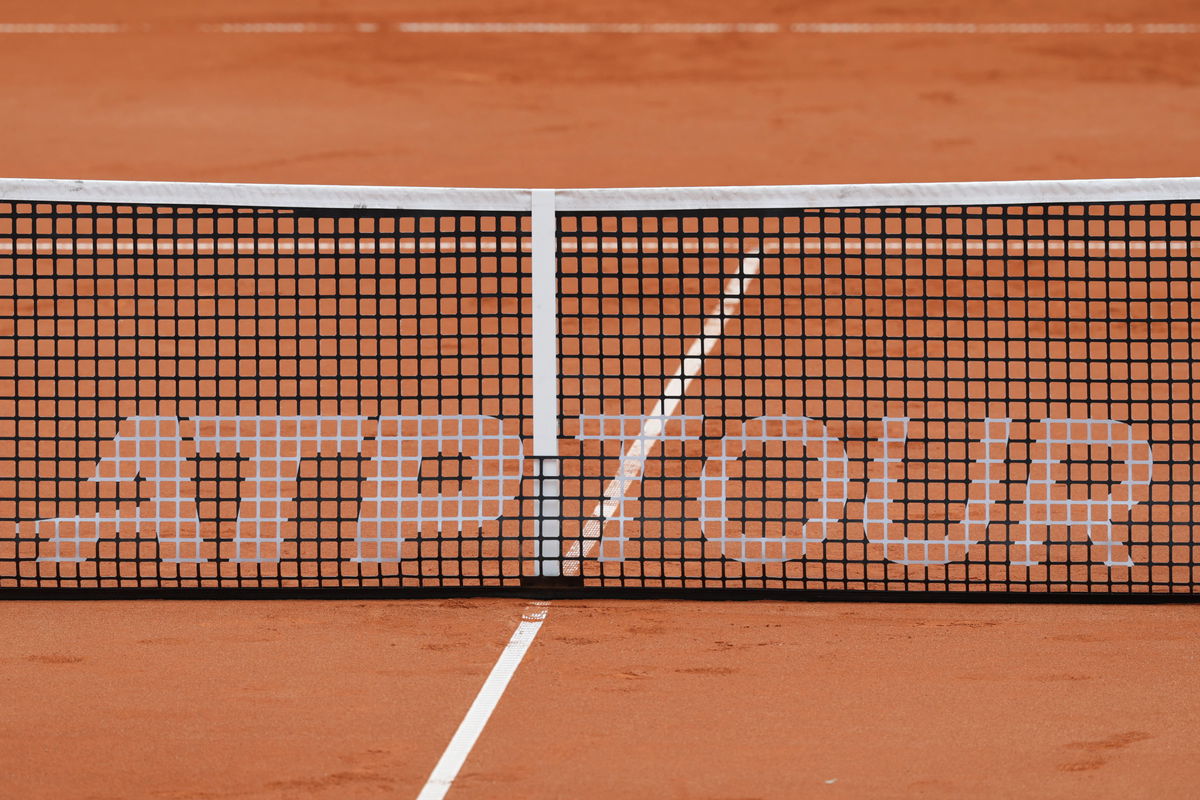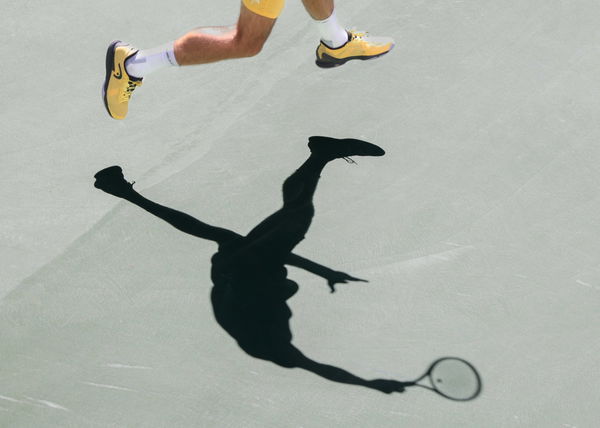
Imago
GER, Hamburg, xFSx, ATP500 Herren-Tennistunier Bitpanda Hamburg Open 2025, 17.05.2025 Marko Topo GER – Emilio Nava USA Tennisnetz ATP, Tennis Herren TOUR Themenfoto, Themenbild, Symbolfoto, Symbolbild, Stockfoto *** GER, Hamburg, xFSx, ATP500 Mens Tennis Tournament Bitpanda Hamburg Open 2025, 17 05 2025 Marko Topo GER Emilio Nava USA Tennis Net ATP TOUR Theme Photo, Theme Picture, Symbol Photo, Symbol Image, Stock Photo Copyright: HMBxMedia/FernandoxSoares

Imago
GER, Hamburg, xFSx, ATP500 Herren-Tennistunier Bitpanda Hamburg Open 2025, 17.05.2025 Marko Topo GER – Emilio Nava USA Tennisnetz ATP, Tennis Herren TOUR Themenfoto, Themenbild, Symbolfoto, Symbolbild, Stockfoto *** GER, Hamburg, xFSx, ATP500 Mens Tennis Tournament Bitpanda Hamburg Open 2025, 17 05 2025 Marko Topo GER Emilio Nava USA Tennis Net ATP TOUR Theme Photo, Theme Picture, Symbol Photo, Symbol Image, Stock Photo Copyright: HMBxMedia/FernandoxSoares
“Apart from Tecnifibre for the rackets, I don’t have any sponsors since I got dropped by Asics. I buy my clothes and shoes like everyone else. I don’t have an agent; I do my thing on my own in my corner,” Terence Atmane confessed. He’s the Frenchman who stunned Taylor Fritz at the Cincinnati Masters this year. His words echo the silent grind of players beyond the top 50. And now, the ATP has finally answered with a seismic lifeline for those fighting for fair pay.
Watch What’s Trending Now!
The ATP has drawn a new battle line in tennis economics, announcing a record-shattering $32.4 million in ATP Challenger Tour prize money for the 2026 season, a bold leap featuring an additional $5 million in singles compensation compared to 2025. This historic move isn’t just about numbers; it’s a statement of intent, powered by OneVision, the ATP’s ambitious long-term strategic blueprint. Since 2022, Challenger Tour prize money has soared by an astonishing 167%, igniting fresh hope for players fighting their way up the ranks.
At the core of this meteoric rise lies OneVision’s engine of innovation. Through the commercialization of rights under Tennis Data Innovations (TDI), the introduction of premium Challenger 175 events, and the creation of a dedicated Challenger Tour team, the ATP has crafted new pipelines of revenue that flow directly into players’ hands. It’s not just reform, it’s a revolution from within, designed to give the sport’s heartbeat, its players, a fairer pulse.
ADVERTISEMENT
ATP Chairman Andrea Gaudenzi captured the essence of this transformation perfectly: “Challenger Tour prize money has nearly tripled since 2022. This is what OneVision was designed to do – create the foundation for investment in our sport to deliver greater financial security to more players. There’s more room to grow. And we’re working to unlock the opportunities to build on this progress.” His words ring with conviction. A promise that this momentum is only the beginning.

Imago
Schatten von Nuno Borges POR von oben, Symbolfoto, US Open 2024, Billie Jean King Tennis Center, New York, USA, *** Shadow of Nuno Borges POR from above, symbolic photo, US Open 2024, Billie Jean King Tennis Center, New York, USA, Copyright: xJuergenxHasenkopfx
The movement doesn’t stop at money; it’s about visibility and reach. In 2025, the ATP struck a landmark global media partnership with Tennis Channel, expanding Challenger Tour broadcasts to 20 countries and amassing a record 33.8 million total viewership.
ADVERTISEMENT
For a tour once lurking in the shadows, this is a dazzling spotlight. The Challenger circuit has become the stage where the sport’s future stars now command global screens, carrying the spirit of ambition and raw grind.
Come 2026, the expansion will hit another gear. The calendar will swell from 216 to 265 events, introducing 50 new Challenger 50 tournaments, each one a gateway for emerging talent to rise, compete, and carve their names into tennis history.
ADVERTISEMENT
This expansion will cement the Challenger Tour as a true springboard to the ATP elite, tightening the gap between dream and reality for countless players.
This surge of prosperity follows earlier reforms. In just the first quarter of 2025, the ATP Challenger Tour distributed $6.3 million in prize money. It’s up from $4.5 million last year and $2.1 million in 2022, marking a thunderous 200% increase in just three years. The impact has been seismic, especially across the player rankings.
Players ranked between 101–175 pocketed $1.4 million collectively in Q1, a far cry from the $468,000 earned over the same period three years ago. A total of 203 players crossed the $10,000 mark this year, a dramatic climb from 147 last year and a mere 44 in 2022.
ADVERTISEMENT
Yet, as Challenger players rise on the tide of reform, a new storm brews on the horizon, the Grand Slam Pay Fight, where even the game’s giants are now demanding structural fairness in a sport caught between glamour and grind.
Coco Gauff calls for Grand Slam prize boost
With total Grand Slam prize money climbing to nearly $440 million in 2025, the season has become a financial milestone for tennis. Yet, as the figures soar, an uncomfortable question resurfaces: how evenly is this wealth being shared? Beneath the shine of the sport’s riches, discontent brews among players demanding a fairer slice of the pie.
ADVERTISEMENT
Among those leading the charge is Carlos Alcaraz, who co-signed a formal letter to Grand Slam organizers on July 30, pushing for systemic reform. With rare candor, he called the current landscape “A little bit a mess between everything… The ATP and the Grand Slams,” while affirming that players are “Trying to make things better.” His words cut through the politics, reflecting a growing unity among the game’s biggest names.
Standing alongside him is Coco Gauff, the reigning star balancing brilliance on court with purpose off it. When asked about elite players demanding a fairer Grand Slam pay structure, Gauff explained, “It’s been a very long process. There is a players’ representative who I want to have a say because I couldn’t attend the meetings as I had training at that time. I was informed, and I don’t have much information; all I know is that this started this past Indian Wells, and I signed the letter along with the other top 10 players.”
Top Stories
Aryna Sabalenka Breaks Silence on Nationality Switch After Belarus Representation Ban

Paula Badosa Trains With 17-Year-Old Star in Unconventional Move Toward 2026 Comeback

Aryna Sabalenka and Nick Kyrgios Go ‘Uncensored’ on Transgender Debate, Serena Williams’ Comeback & More

Elena Rybakina Backed by Ex-Pro as Controversial Coach Sparks Her ‘Machine’ Mode

Brothers Valentin Vacherot and Arthur Rinderknech Turn Heads With Unexpected Australian Open Announcement

Her motivation runs deeper than personal gain. “The goal is to boost the prize money for players in Grand Slams, not just for us but also for players ranked in the top 200 or 300,” she continued.
ADVERTISEMENT
Gauff’s final words strike hard: “We are trying to leverage the fact that the top-ranked players can exert pressure and are listened to a bit more, unfortunately.”
With that truth out, all eyes now turn to 2026. A pay raise could rewrite tennis’s story, not just in numbers. But in fairness and spirit.
ADVERTISEMENT
ADVERTISEMENT
ADVERTISEMENT

